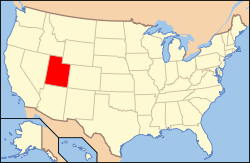Emery, Utah
| Emery, Utah | |
|---|---|
| Town | |

Emery LDS Church, built 1898−1900, is the oldest surviving religious building in town.
|
|
 Location in Emery County and the state of Utah |
|
 Location of Utah in the United States |
|
| Coordinates: 38°55′20″N 111°14′58″W / 38.92222°N 111.24944°WCoordinates: 38°55′20″N 111°14′58″W / 38.92222°N 111.24944°W | |
| Country | United States |
| State |
|
| County | Emery |
| Named for | George W. Emery |
| Government | |
| • Mayor | Mistie Christiansen |
| Area | |
| • Total | 1.2 sq mi (3.0 km2) |
| • Land | 1.2 sq mi (3.0 km2) |
| • Water | 0.0 sq mi (0.0 km2) |
| Elevation | 6,253 ft (1,906 m) |
| Population (2010) | |
| • Total | 288 |
| • Density | 247/sq mi (95.3/km2) |
| Time zone | Mountain (MST) (UTC-7) |
| • Summer (DST) | MDT (UTC-6) |
| ZIP code | 84522 |
| Area code(s) | 435 |
| FIPS code | 49-22870 |
| GNIS feature ID | 1440926 |
Emery is a town in Emery County, Utah, United States. The population was 288 at the 2010 census.
Emery sits at the base of the mountains that contain the North Horn Formation. Named after North Horn Mountain, near Castle Dale, this formation in Emery County contain numerous Cretaceous- and Tertiary-era fossil invertebrates, microfossils and palynomorphs. Flagstaff Peak, north of Emery, has abundant dinosaur bone material, prehistoric mammal remains, and petrified dinosaur footprints.
The Fremont culture or Fremont people is a pre-Columbian archeological culture who existed in the area from AD 700 to 1300. It was adjacent to, roughly contemporaneous with, but distinctly different from the Ancestral Pueblo peoples. The culture received its name from the Fremont River, where the first Fremont sites were discovered. The Fremont River in Utah flows from the Johnson Valley Reservoir near Fish Lake east through Capitol Reef National Park to Muddy Creek, whose headwaters begin just north of Emery.
Two significant Fremont culture sites are located north and south of the town. Artifacts such as pottery, manos and metates (millingstones), and weaponry have been found along Muddy and Ivie creeks. Coil pottery, which is most often used to identify archaeological sites as Fremont, is not very different from that made by other Southwestern groups, nor are its vessel forms and designs distinct. What distinguishes Fremont pottery from other ceramic types is the material from which it is constructed. Variations in temper, the granular rock or sand added to wet clay to insure even drying and to prevent cracking, have been used to identify five major Fremont ceramic types. They include Snake Valley gray in the southwestern part of the Fremont region, Sevier gray in the central area, Great Salt Lake gray in the northwestern area, and Uinta and Emery gray in the northeast and southwestern regions. Sevier, Snake Valley, and Emery gray also occur in painted varieties. A unique and beautiful painted bowl form, Ivie Creek black-on-white, is found along either side of the southern Wasatch Plateau. In addition to these five major types found at Fremont villages, a variety of locally made pottery wares are found on the fringes of the Fremont region in areas occupied by people who seem to have been principally hunters and gatherers rather than farmers. The Rochester Rock Art Panel 3 miles (5 km) west of Emery is a significant rock art panel left by the Fremont People and has been the target of vandalism and relic thieves.
...
Wikipedia
